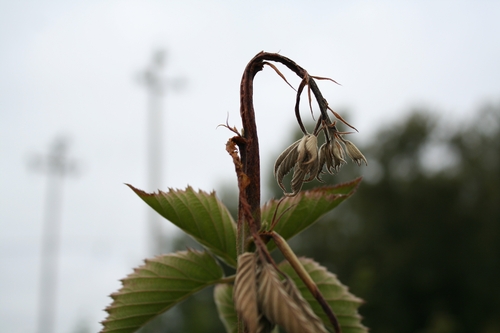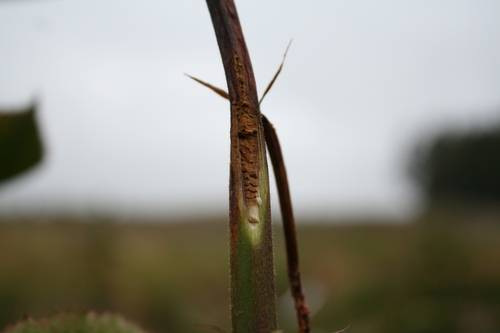Posts Tagged: dieback
Tip Dieback on Arapaho Variety Blackberry
The following is a description and evaluation of tip dieback in Arapaho blackberry in a field outside of Watsonville .
As the reader can see from the pictures below, the issue is a rather abrupt manifestation of wilt, followed by a blackening of the tip. Cutting back the outer layer of the cane reveals (Photo 2 below) that the necrosis is advancing in the interior of the cane, but as with the tip blackening itself, seems to be restricted to the top 4 or 5 inches.
This problem of tip dieback was reported some weeks ago on a few tips of the Arapaho planting and none of the other varieties in the same field. As of last week this dieback has advanced through most of the planting and most of the tips are now affected and again restricted only to Arapaho.
There are no signs, for example oozing typical of bacteria or fruiting bodies or mycelium associated with a fungus, of disease. Seeing that the tip dieback is similar to the blackening of young leaf tissue caused by insufficiency of calcium ( for example black heart in celery) we tested with a two replicate sample the nutritional status of cane tips just starting to wilt and compared them to others still apparently healthy. The output of this evaluation is below. Also please note that substantial portions of cane were included in the sample, which would be expected to have different - probably lower - levels of minerals than the normally tested leaf tissue.
Table 1: Comparison of Mineral Concentrations of Healthy and Tip Burned Tissue on Arapahoe Blackberry.
|
Mineral |
Healthy |
Tip Dieback |
|
Total Nitrogen |
2.7% |
2.0% |
|
Total Phosphorous |
0.44% |
0.25% |
|
Potassium |
2.2% |
1.4% |
|
Calcium |
0.74% |
0.87% |
|
Magnesium |
0.47% |
0.47% |
|
Total Sulfur |
0.24% |
0.16% |
|
Copper |
5.3 ppm |
4.8 ppm |
|
Zinc |
56 ppm |
36 ppm |
|
Manganese |
395 ppm |
510 ppm |
|
Boron |
23 ppm |
20 ppm |
|
Molybdenum |
0.47 ppm |
0.87 ppm |
|
Sodium |
200 ppm |
265 ppm |
|
Chloride |
425 ppm |
830 ppm |
Concentrations of nitrogen, phosphorous, potassium, sulfur, copper and zinc are higher in the healthy tips, while concentrations of manganese, calcium, sodium and chloride are higher in the wilted tips. While the levels of chloride are nearly double in the cane which has died back, these levels of chloride are still not consistent with what we know to be damaging to plant tissue, usually ranging about 3000 or 4000 parts per million.
Considering that if the problem is not a disease, nor nutritional, what is it then? The answer comes to us from people with experience with the variety and the problem. We go to John Clark from the University of Arkansas, who has noted previously this very tip dieback on Arapaho blackberry in cooler climates (for which the summer Central Coast obviously qualifies) to the extent that he cautions growers in cooler regions about planting it.
In conclusion we can be fairly certain that the tip burning we are currently observing here in Arapaho blackberry is physiological and caused by an interaction of the variety and our climate.

Tip dieback on Arapaho blackberry

Cutaway of Arapaho cane affected by tip dieback.

